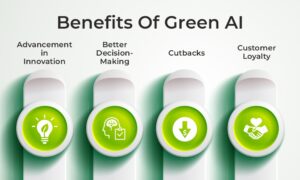Advancements in technologies like AI in the IT sector have completely changed industries and businesses. Can we use that technology to do something good for the environment?
Yes! Through Green AI.
The talks on climate change are happening between countries with time to discuss how technology can play a role in mitigating the effects of climate change. As a result, organizations are turning gradually more towards environmentally friendly technologies, like Green AI, to contribute to cutting down the carbon footprint.
Green AI: What is it?
Green AI uses various AI procedures in different industries to elevate green development and minimize the influence of traditional AI technologies.
But how does one reduce the carbon footprint of AI?
As technology advances, so do its use cases. The use of AI has increased recently in all industries. It is a welcoming change, but there are environmental and sustainability impacts as collateral. When a huge and impactful technology comes to fruition, there is very little thought given to the effects it may have on the environment. So, naturally, until Green Artificial intelligence was developed, the traditional AI developments and its deployment always focused on increasing the performance of the technology. As a result, the consumption of energy and electricity increased. Measuring the carbon footprint of AI is challenging, and the majority of users don’t know the effects of its different uses.
Green artificial intelligence can be the answer to these challenges. Green Artificial intelligence aims to upgrade the AI models, so they become economical, utilize less energy, and are all-friendly all-round. Methodologies of this AI also welcome renewable energy sources whenever plausible. Putting ecological implications into perspective is made easier by measuring the environmental impact of different AI use cases
Propositions for the Progress of Green AI and Machine Learning
For the progress of Green AI, it is of utmost importance that the organizations emphasize strategies that cushion the environmental implications of AI. Some methodologies can include making use of environmentally sound structures for making the systems green, establishing smart management of data, and planning algorithms with sustainability goals through the use of green artificial intelligence in mind. This combination can be a transforming one for organizations as this can lay the foundation for success in sustainability.
When sustainability is spearheading the development of AI, it will guide the systems developing AI in keeping the environment in mind. This AI tries to reduce the environmental footprints of the AI systems and not only that but also wants to address the bigger environmental challenges. Correct use of Green AI by organizations can bring sustainability in the current organizational setting and future.
What Benefits Does Green AI Offer?
Advancement in Innovation is promoted along with new changes in technology and endeavors for sustainability. Addressing the issues that concern the environment at the time of brainstorming has to be important for businesses.
Better Decision-Making from the businesses whose analytics and insights are AI-powered, can be expected. This helps businesses make informed decisions, while emphasizing the efforts for sustainability and better employment of resources. As a result, this leads to better efficacy and performance, whilst various tasks are automated through AI.
Cutbacks on costs are also an advantage here. Optimization of resources is a key element of Green Artificial intelligence. This leads to cost saving in organizations across different businesses due to less use of resources like water, electricity, energy, etc. This in turn makes the organizations sustainable.
Customer Loyalty increases, as most customers today also look for whether the business they are buying from are supporters of efforts to environmental sustainability. Hence, executing Green artificial intelligence practices will satisfy the environmental concerns of the customers.
Challenges that Green AI Comes With
Nothing can develop further if there are no challenges to face. Challenges give us the incentive to innovate and design solutions to upgrade technology further. The most relevant challenge is to align AI goals with sustainability objectives.
Ethics must be integral to any system that involves integrating Green artificial intelligence into an organization, addressing various ethical concerns, including bias, transparency, data, privacy, and accountability. Ethical guidelines need to be established to subdue these concerns before implementing Green artificial intelligence technologies.
A Gap in Skill levels is also a matter of concern, as people who are skilled in both artificial intelligence and sustainability are in short supply. When there is a shortage of talent, organizations should train their existing employees on the new technologies that will be implemented.
The Quality of Data needs to be of the highest level for Green artificial intelligence to perform correctly. By doing this, businesses can make informed decisions. It is a challenge to acquire the relevant data to train the AI. Establishing data governance frameworks that validate high-quality data is one way to address the challenge of acquiring relevant data.
How Can Organizations Implement Green Artificial Intelligence?
The following steps can be taken to establish Green artificial intelligence practices.
Establish objectives: Businesses need to decide which specific sustainability objectives they want to accomplish and how they relate to other business objectives. How Green AI can help achieve these sustainability objectives should be the focus.
Evaluate currently available data: When creating and training green artificial intelligence models, it’s critical to evaluate the data that will support an organization’s sustainability initiatives.
Integrate AI solutions into workflow: A smooth transition can be achieved by implementing and integrating Green artificial intelligence into current procedures and systems. Businesses should ensure that these solutions are both scalable and compatible with their current infrastructure.
Creating Green artificial intelligence models: Utilizing AI and ML models to analyze the organization’s historical data will facilitate informed decision-making in the future. Decisive actions can be taken by creating and refining Green AI models for particular sustainability-related use cases.
Performance evaluation and monitoring: Businesses need to monitor the performance of their recently deployed Green AI models and assess how these initiatives impact sustainability objectives. This entails getting input and adjusting as necessary.
Parting Ways to Keep in Mind
Green AI’s rise emphasizes how important it is to use energy-efficient machine learning techniques, underscoring the fact that sustainable technology is crucial to innovation and environmental responsibility in the future. By putting energy efficiency first, we can maximize AI’s potential while reducing its environmental impact, opening the door to a more sustainable technological future.
Frequently Asked Questions (FAQs)
1. What is Green AI?
Green AI introduces the development and use of artificial intelligence models and algorithms that emphasize energy efficiency, reduced carbon emissions, and sustainability while improving performance.
2. How can businesses adopt Green AI practices?
Businesses can:
– Use cloud providers powered by renewable energy
– Implement model compression and lightweight algorithms
– Invest in energy-efficient hardware
– Monitor and report AI energy consumption metrics
3. What is the future of Green AI in machine learning?
The future of Green AI will involve self-optimizing models, renewable-powered supercomputers, and global standards for measuring AI’s environmental footprint—paving the way for a sustainable AI ecosystem.
Don’t miss the latest trending blog updates. Check out our blog section today!



